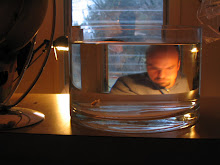Yesterday - and I know this will sound a touch ridiculous, but it's simply where things are at the moment - yesterday Cleo and I discovered the Best Sidewalk in Baltimore. After a week and a half of bouncing over canted courses of concrete, of pausing before chasms and steering around fallen branches, we hit the jackpot. At the end of Longwood Avenue, in beautiful Roland Park, there's a sidewalk set into a sloped hill (for a look, click here, and on Street view, and then face south): it's smooth and as it clings to the hill, below several large houses, it really resembles, in miniature, a path in the Cinqueterre. At points a full 7 feet above the street below, it's nothing if not picturesque.
And it has, it seemed to me as we rolled along beneath spangles of sun, an actual narrative value. It begins with a soft ascent and eventually reaches a sort of climax at its greatest height. There was even a hint of conflict, of work to be done, in the strong scent emitted by a pile of mulch. All leading to a resolution: a gradual descent, until our stroller was deposited, like a paper boat sent by a stream into a larger river, back on the street.
I spent a moment trying to think of musical parallels: are there themes that have a comparable rise and fall, a similar narrative implication? Well, one example came to this weary, unmusical mind: Peter's theme, from Peter and the Wolf, Prokofiev's 1936 musical symphony for children. I don't know much about Prokofiev, but I know that piece well: it got some airtime on my dad's record player when I was little. You probably know it, too, even if you don't think you do: often narrated, it tells the story of Peter, a young Soviet pioneer, who wanders into a meadow, where he eventually meets and captures a wolf.
Each of the characters - Peter; the wolf; a hunter; a duck - in the symphony is associated with a particular theme, and Peter's is undoubtedly the most famous. Here's a link to an MP3 version of it: just click on Preview All. Prokofiev seems to have been thinking impressionistically; the lush strings suggest a fertile meadow, and the strong rhythm evokes a gamboling, wide-eyed boy. But what I'm really interested in is even more evident in the published score: Peter's theme, like our sidewalk, rises and then falls. It leads upwards, and implicitly outwards, and then suggests a sense of familiarity, or relaxation, through the descent of tones and the longer, held tones at the end. It bounces, like a boy, and is utterly whistleable, as any tune meant to be associated with a walk should be.
So if you happened to be driving down Longwood yesterday at about 11:30 (but I know you weren't; there's never any traffic there), and looked up to your left, that was Peter, wandering into the meadow and leaving the gate wide open as he pushed a stroller.
Subscribe to:
Post Comments (Atom)




No comments:
Post a Comment